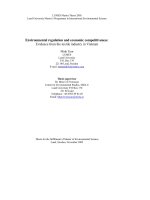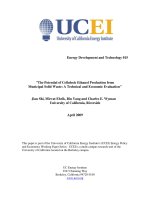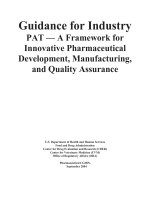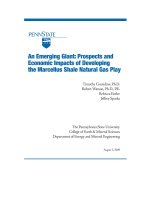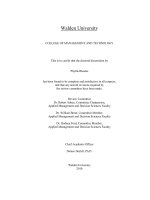Collaboration for Agriculture & Rural Development: Technical and economic feasibility of applying the Better Management Practices (BMP) to household aquaculture in Vietnam " MS6 pot
Bạn đang xem bản rút gọn của tài liệu. Xem và tải ngay bản đầy đủ của tài liệu tại đây (531.2 KB, 19 trang )
Ministry of Agriculture and Rural Development
COLLABORATION FOR AGRICULTURE AND
RURAL DEVELOPMENT (CARD)
002/05 VIE
Technical and economic feasibility of applying the
Better Management Practices (BMP) to household
aquaculture in Vietnam
MS 6: BMP training manual
ENVIRONMENT MANAGEMENT IN AQUACULTURE
Mai Van Ha
Nguyen Duc Binh
Research Institute for Aquaculture No.1
Bac Ninh, 2007
INTRODUCTION 4
1. ENVIRONEMNT MANAGEMENT IN POND AQUACULTURE 4
1.1. Why environment management 4
1.1. What influences water quality 4
1.2. Environment management of culture area and ponds 5
2. ENVIRONMENT PARAMETERS 5
2.1. Culture area and water depth 5
2.2. Water temperature 5
2.3. Water transparency 6
2.4. Water color 6
2.5. pH 6
2.6. Dissolved Oxygen (DO) 7
2.7. Salinity 7
2.8. Alkalinity 7
2.9. Biologically decomposable matter (measured as COD and BOD) 8
2.10. Ammonium (NH
4
+
) 8
2.11. Phosphorus PO
4
3-
8
2.12. Amonia (NH
3
) 9
2.13. Nitrite (NO
2
) and Nitrate (NO
3
) 9
2.14. Hydrosunfure (H
2
S) 9
2.15. Iron ( Fe
2+
, Fe
3+
) 10
3. MEDTHODS AND ENVIRONMENTAL STANDARDS 11
3.1. Methods of water quality analysis and measurement 11
3.2. Environmental standard/norm in aquaculture 11
4. SAMPLING STRATEGY AND PRESERVATION METHOD 12
4.1. Critical rules of sampling method 12
4.2. Sampling procedure 12
5. EFFECTS OF ENVIRONMENTAL FACTORS TO SHRIMP HEALTH 13
5.1. Weather and climate condition 13
5.2. Pond characteristic 14
5.3. Effects of weather condition on environment of shrimp ponds 14
6. ATTENTIONS ON SHRIMP CULTURE MANAGEMENT 14
6.1. Geographical location and environment 14
2
6.2. Culture management 15
7. POND PREPARATION 15
7.1. Lime utilization 15
7.2. Use of algicide 16
7.3. Treatment of in-pond produced substances 16
7.4. Disinfection 17
7.5. Removal of Plankton and benthic organism 17
7.6. Water color induction fertilization 18
8. REFERENCES 19
3
INTRODUCTION
Aquaculture in Vietnam, particularly shrimp culture has been developing rapidly with reagrds
to both acre and production. However, shrimp productivity is unstable, product quality and
sanitation requirement is getting worse. It is uncontroversal that unplanned development and
limited technical know-how are the disadvantegs. Under CARD- funded project “Technical
and Economic Feasibility of Applying Better Management Practices to household
aquaculture in Vietnam” environment management activities was a critical component that
support a succesful application of BMP protocal among aquafarmer community.
The decoment represents water quality management princible, practical aspects, real coming
up issues and its remediation acordingly.
1. ENVIRONMENT MANAGEMENT IN POND AQUACULTURE
1.1. Why environment management
Pathogens
Host
Water
Figure 1: Relationship environemnt- related component in water
+ Water environment is habitat of aquatic animals including aquaculture species
+ Good environment ensures higher growth rate of culture and less disease caused-
agents
+ Poor water quality results in poor growth of culture and more disease germs.
Water quality management is to minimize risk of water pollution (limited toxic
subtances and disease germ)
1.1. What influences water quality
+ Weather condition (rainy, sunny, stormy)
+ Bottom soil property: sand/dy, mud/dy.
+ Human- origined influences
4
1.2. Environment management of culture area and ponds
* What water parameters needs monitoring
+ Pond area, water deapth
+ Transpearency (by algae density)
+ pH, alkalinity, salinity
+ Dissolved oxygen (DO)
+ Toxic gases: NH
3
, NO
2
, H
2
S, CH
4
+ Organic sediments: assessed via content of COD and BOD
+ Nutritional form: NH
4
, PO
4
* Where to monitor within culture area
Water course, dishcarged water and inside ponds
2. ENVIRONMENT PARAMETERS
2.1. Culture area and water depth
+ Suggested culture area of more than 3000m2
+ Suitable water depth of 1.2m – 1.6m (1,5m - 2,0m)
Appropreate culture and less changeable water depth will experience less fluctuation of water
temperature due to suddenly change of wheather condition like heavy rain, sunny, monsoon,
Water depth measurement is normally checked using depth gause fixed in the pond during
culture duration
2.2. Water temperature
+ Culture species like shrimp and crab are cold- blooded,
body temperature change following ambient environment.
Sun energy plays an crucial role in feed ingestion and
nutrient uptak. Suitable water temperature for black tiger
shrimp is 25 - 33
o
C.
+ Water temperature change with the change in diunal and
seasonal weather condition. It is normally higher during
daytime and summer time.
+ It is an advantage of water that heat holding capacity is quite high leading to more stable
water temperature than embient temperature. Familiar tool to check water temperature is
themometer
5
2.3. Water transparency
Water transparency is an indication of:
+ Algal community
+ Light panitration
In shrimp ponds suitable algal density of more than 2 mil.
cells/l, equavilant to transparency of 10 - 40 cm.
Secchi disc
In natural water body, less algal community obsered,
normally less than 1 mil. cells/l, if no alluvium and colloid
present water clearness up to 100 cm. Suitable transparency in aquaculture is of 25-40 cm.
Secchi dics is used to measure water transparency
2.4. Water color
Water colour experienced from:
+ Sand, alluvivum, colloid, .
+ Plankton organism: mainly algae
- Cyannophyta causes water greeny,
- Euglenophyta cause brownish yellow,
- Dinophyta/ Pyrophyta causes brown or blackish brown colour.
- Chrophyta, bacillariophyta experience blue colour
- Organic ditritus: blackish and stenchy.
What water colour influences water quality
+ It really depends on what is the constitution of warter colour. Water with greater alluvium,
organic sediment, phytoplankton has higher nutrient level.
+ If scum of any form and colour appears on the water surface there shoule be a need to
remove or water exchanged.
Giving a frequent observation on water color as it is an indication of positive or negative
message resulting to a further right remediation and treatment.
2.5. pH
pH of of any water falls into 1- 14
+ Acidic water: pH < 6,5
+ Neutral water: pH from 6,5 – 8,5
+ Alkaline water: pH > 8,5
What causes the chagne in pH
+ Acid rain resulting pH reduction
+ Water exchange leading pH fluctuation
6
+ Algal community (high algal density experiences greater gradient of pH)
+ Liming during pond preparartion and treatment/disinfection
What influences caused by pH changing
+ Low pH cause more PO
4
absorption by bottom sediment leading to poor algal community
+ Low pH induces more heavy mental resuspention from pond bottom.
+ Great fluctuation of pH causes stress for culture species, more susceptible to disease
infection as a result.
2.6. Dissolved Oxygen (DO)
DO comes either from:
+ Disfusion from atmosphere
+ Photosynthesis by phytoplankton community: CO
2
+ H
2
O > living biomass + O
2
+ Oxygenation devices/aeration
Lossing DO due to:
+ Respiration of aquatic animals
+ Baterial decomposition of organic matter: uneatent fish, dead animals
Pond fertilisation regime and feeding startegy should be well planed, regular checking
DO to avoid anoxic condition.
The role of DO to aquatic animals
+ Consumed in all organic oxidation and toxic gases degeneration
+ DO should maintained at more than 5,0 mg/l.
+ A suggested algal density of 2 – 5 mil./l could balance DO at a right level in water.
+ Phytonsynthesis by aquatic plant and alage causes significant diual fluctuation of DO,
minimum level of pH falls at 4 – 5 AM while highest value can be recorded at 1-2 PM.
2.7. Salinity
Salinity, mainly known as NaCl, gives suitable concentration for many aquaculture species at
15-25‰
2.8. Alkalinity
What constitutes alkalinity
+ Alkalinity measured as mg CaCO
3
/l indicates concentration of ions HCO
3
, CO
3
2-
, OH
-
present in water.
+ Hardness as mg CaCO
3
/l is measured by ion level of Ca
2+
và Mg
2+.
What is the role of alkalinity
+ The concentration of Cacbonate (CO
3
2-
) and bicacbonat (HCO
3
-
) compounds is
7
propotional to primary productivity by phytoplankton, that’s why pond of higher
alkalinity level will give higher yeild of culture species.
+ Liming (use of CaCO
3
) is a enevitable key to encrease alkalinity to suggested
concentration of 80-120 mg/l.
2.9. Biologically decomposable matter (measured as COD and BOD)
In natural waters and culture ponds, besides respiration process of aquatic animals that
consume oxygen, a careful consideration needs to pay on intertrasformation of organic maters
(quantified as mg DO/l as COD and BOD) that also realy use a great amount of DO.
Where BOD and COD comes
Due to the accumulation of detritus, uneaten feed, excreate of culture species, dead oganisms.
Possible impacts
COD >30mg/l ; BOD >10mg/l ( an indication of water pollution
COD from 10-20mg/l ; BOD from 5 – 10mg/l (suitabe level for aquaculture
COD < 10mg/l ; BOD < 5mg/l (poor potential nutrient loading).
2.10. Ammonium (NH
4
+
)
Nitrogen nutrient can be of: NH
4
, NO
2
, NO
3
-
+ NO
2
can be easily transformed to NH
4
or NO
3
depending on DO level and microoganism.
+ NH
4
and NO
3
-
can be directly uptaken by phytoplankton community, especially by
microalgae
Where they comes from:
Nitrogen fixation bacteria (symbiosis to phytoplankton or water hyacinth)
Biological decomposition of organic mater including detritus and dead aquatic organisms
to produce inorganic nitrogen as following: Organic nitrogen- > NH
4
Æ NO
2
Æ NO
3
-
Additional pond fertilisation. It is noted that frequent application of Urea will results in
loower water and bottom soil pH.
2.11. Phosphorus PO
4
3-
Where it comes from
+ Resuspension from bottom soild/mud in certain condition: Availability of phosphorus
in bottom soil, pH of water (greater rate of phosphorus resolution at high pH).
+ Decomposition of organic matter
+ Additional fertilisation (use of phospate fertilizers)
What form of phosphorus found in water
+ Phosphate compounds: PO
4
, HPO
4
, H
2
PO
4
-
8
+ Soluble reactive phosphorus: PO
4
Phosphorus is a controlling element of water’s productivity based on algal yield. The
concentration of PO
4
at 0.3-0.5 mg/l is recognized suitable for pond aquaculture.
2.12. Amonia (NH
3
)
+ NH
3
is generated during decomposition of rich
nitrogen compound.
+ In alkaline water, all NH
4
will be converted into
NH
3
NH
3
+ H
2
O <===> NH
4
+
+ OH
-
Possible impacts by NH
3
+ NH
3
is really toxic to aquatic organisms, while
NH
4
+
is of harmless.
+ Organic polluted water normally has NH
3
concentration of more than 1,0 mg/l.
How to eliminate NH
3
+ Good feeding strategy (amount and frequency).
+ Water exchange and addition
+ Control pH of not over 8,0 and water temperature less than 32
o
C
+ Maintaining right level of alkalinity and hardness
2.13. Nitrite (NO
2
) and Nitrate (NO
3
)
Where it comes
+ Nitrite is an intermediate product of organic nitrogen deomposition process. In oxic water,
ammonium (NH
4
+
) will be biologically oxidized to nitrite (NO
2
-
) and then nitrate (NO
3
-
).
+ While in anoxic environemnt, NO
3
-
will be reduced to NO
2
-
.
+ Pond of well- management and aeration, NO
3
-
level is normally high and low NO2; and vi-
versa.
What influences
+ NO
2
-
level is an indicates of pond condition: poor water quality. Low DO and pollution.
+ NO
2
-
can even be toxic to culture species at quite low concentration of 0,1 mg/l.
+ NO
3
-
is harmfulless to aquatic anaimals
2.14. Hydrosunfure (H
2
S)
Where it comes
+ Mainly from decomposition of dead aquatic organisms
+ Anoxic organic decomposition
+ Acummulation of organic sediment
9
What influences to environment and culture species
+ H
2
S is a gas of rotten- egg stench and toxic
+ High solvency capacity in water experiencing low acidic water acordingly.
+ H
2
S will combine blood oxygen leading to anoxia symtom, and stain nervous system aas a
result
+ Concentration of H
2
S in water ranges more os less 1,0 mg/l.
How to eliminate H
2
S
+ Oxygenation
+ Removing bottom mud layer
+ Replacing with clean water
2.15. Iron ( Fe
2+
, Fe
3+
)
Where they come
+ Soil (high land and stone) with high level of FeO, Fe
2
O
3
+ Coastal soil and tidal zone of high FeSO
4
.
Influence in water environment
+ Water dissolved ferrous compounds to release ion Fe
2+
, Fe
3+
+ Solvency of iron compound is higher in acidic environemnt (low pH)
+ In alkaline environment iron ions will form precipitated hydroxyte.
Remediation to discard iron
+ Water aeration for precipitation forming on bottom that required to remove in the and of
production cycle.
+ Liming will lead to precipitation down to pond bottom
10
3. METHODS AND ENVIRONMENTAL STANDARDS
3.1. Methods of water quality analysis and measurement
Method
Or. Water parameter
Sensor Test Kit Chemical Others
1 Water depth Fixed ruler
2 Water temperature + Themometer
3 Transparency Secchi disc
4 Water colour Naked eyes
5 pH + + +
6 DO + + +
7 Alkalinity + +
8 Salinity + + Hydrometer
9 COD and BOD +
10 NH
4
+
and PO
4
3-
+ +
11 NH
3
,NO
2
và NO
3
+ +
12 H
2
S + +
13 Fe total + +
3.2. Environmental standard/norm in aquaculture
Or. Water parameter Unit Norm
1 Water temperature
o
C 25 – 33
2 Transparency cm 25 – 40
3 Water depth m 1,2 - 2,0
4 Water colour Green/Yellow/Greenish
yellow
5 pH 7,5 - 8,5
6 DO mg/l > 5,0
7 Alkalinity mg/l 80 – 120
8 Satlinity
‰
15 – 25
9 COD mg/l 10 – 20
10 BOD mg/l 5 – 10
11 NH
4
+
mg/l 0,5 - 1,0
12 PO
4
3-
mg/l 0,3 - 0,8
13 NH
3
mg/l < 0,10
14 NO
2
mg/l <0,25
15 H
2
S mg/l < 0,01
16 Fe total mg/l < 0,10
17 Soil composition Cát
11
4. SAMPLING STRATEGY AND PRESERVATION METHOD
Sampling strategy and analysis method have to be
consistant. Sample should be representative too ensure that
environment assessment is close to reality as well as time
and money saving. For example, to understand duially
variation of DO, it is theoritcally clear that DO level is low
in night and lowest in early morning because of no
photosynthesis, only respiration taken place. Knowing the
time of lowest DO level is more meaningful than other
time piont.
On the other hand, finding out rules of unequal distribution
of some ecnvironment parameters by surface and water column so sample should be collected
in typical position and different layers of water column, so interpretation can be done
correctly
4.1. Critical rules of sampling method
+ Periodic sampling: to find out variation of environment factors, sampling have to be done
weekly, monthly, quaterlr or annually.
+ Time of sampling: In a day, sample should be collected in early morning, 4-5am in summer
and 5- 6pm in Winter.
+ Sampling point/position: 1 to 3 samples for small pond, 3 to 5 one for larger pond
4.2. Sampling procedure
Preparation step
+ Sampling tools preparation (tools, chemical substances, machines, test-kit, sample botle
container).
+ Books and pens are necessary
Sampling step (on- field)
+ Taking a view and sellect presented position for sampling
+ Collecting water samples, fix these samples and measure parameters which can be done on-
12
field (DO, temperature, pH, transparency ).
+ Making notes any ponds- related information (name, location, name of sampling position
and characters of the position). Recording weather condition (sunny or rainny, wind
direction, clouds ). All in one a well-designed data recording book.
Sample analyzing.
+ Depend on distance, if it is not far form laboratory, the samples should be taken to the lab
for analyzing as soon as possible.
+ Samples can be analyzed on-field if it is far from Lab, in this case included appropriate
devices required.
+ If it is not done immediately, the samples should be fixed carefully and kept in cool
condition before taking to the laboratory.
Sample preservation
+ Preservation methods varies depending on parameters to be analyzed
+ Most of samples have to be restored in cool condition 0 to 5
o
C, and keeping period of
within one day.
+ Temperature, pH and Oxygen must be determined on-field
+ Samles for heavy metal,pesticide requires special methods.
Data recording and results of analysis
+ There is a need to have a well-designed data recording book
+ Data need well- computerization in a spread sheet or table making easier for analyzing and
calculating.
5. EFFECTS OF ENVIRONMENTAL FACTORS TO SHRIMP HEALTH
5.1. Weather and climate condition
+ Weather conditrion changes drastically, it affects
shrimp crop and productivity
+ Shrimp crop usually begin after Thanh Minh festival,
about end of March or early April every year when
changing form Spring to Summer so that the weather
become warmer
+ Sometime, the last cold wind may appear during
cutivation.
+ Storms and tropical low pressure also have effects on shrimp crop.
13
5.2. Pond characteristic
+ Consideration of pond supporting infrastructure (area,
depth, sediment )
5.3. Effects of weather condition on environment
of shrimp ponds
Effect of hot weather
+ Hot weather causes of high water temperature, anerobic disitegration process of organic
substances in pond, especially at the bottom of pond, happens quickly. This process produces
toxic in the bottom (20 cm in sediment layer) such as: H
2
S, CH
4
NH
3
, NO
2
, these gases are
harmful for shrimp health.
To NH
3
: Level of NH
3
is directly proposional to temperature and pH
To H
2
S: Level of H
2
S is inversely proposional to temperature and pH.
+ Greater development rate of microorganism: WSSV, MBV, YHV
Effects of heavy rain in the early stage of crop
+ Rain in early stage has serious effects on crop, it deteriorates environemental quality:
chaning pH, salinity,, temperature causing stress on culture species, more susceptibile to
disease infection. Toxic H
2
S releases from sediment to water column, DO level decrease and
shrimp nerves be harmful. As a result, pathogens have a chance to be developed and diseases
outbreak as a results.
6. ATTENTIONS ON SHRIMP CULTURE MANAGEMENT
6.1. Geographical location and environment
Water sourse
+ Availability of water sourse
+ Annual variation of salinity
+ Depth and transparency
+ External effects: transportation, human life activities, factory. Is that cause any water
pollution or not?
+ Inlet and outlet are saperated ot not?
+ Treamtent of diacharged water?
Water discharged system
+ Is drain canal large enough?
+ Waste water treated before draining out
Pedology characters/bottom soil composition
+ Struture of bottom soil
14
+ Is there any water leaking?
+ Position of culture area (high, medium or low tide)
6.2. Culture management
+ Culture operation activities
+ Aquaculture speciality staff
+ Custom, knowledge of farmers
+ Investment and attention of goverment
+ Self- abilities in environment measurement and disease management.
+ Seed management and controlling
+ Desease informing and quaraintining.
7. POND PREPARATION
7.1. Lime utilization
Lime is used in the purpose of decontamination,disinffection and increasing pH and making
pH stable (buffering. L systembased on Carbonic - Bicarbonate – Carbonate balance). Liming
dose is as following: calculated base on pH of soil bottom
Table 1: Ralationship between liming amount and pH of soil bottom (kg/ha)
Soil pH CaO Ca(OH)
2
CaCO
3
CaMg(CO
3
)
2
7,0 - - 500 500
6,0 500 700 1000 1000
5,0 750 1000 1500 1500
4,0 1000 1200 - -
Table 1: Lime using between two crops following pH level
CaO or Ca(OH)
2
pH
kg/ha
4,0 - 4,5 1500
4,5 - 5,0 1250
5,1 - 5,5 1000
5,6 - 6,0 700
6,0 - 6,5 600
6,5 - 7,5 500
Some kinds of lime used aquaculture
1. CaCO
3
, or Dolomite CaMg(CO
3
)
2
15
2. Ca(OH)
2
3. CaO (Quick lime)
Liming time
+ As of CO
2
and PO
4
3-
P reduction, liminbe done before water colour inductiion and
fertilization.
7.2. Use of algicide
High pH is a result of high algal density, so reduction of algal diversity can reduce pH.
Aquacop (1979) has applied algaecide Clarosan (Ciba-Geigy) at 0.02 mg/l within 2 weeks in
Macrobrachium culture- Macrobrachium rosenbergii. Atfer aplication water pH reduces 0.5 -
1,0 unit over 3 hours .
Importantly, water treatment normally read to DO deleption, of course low concentration of
applied Clarosan cause no negative impacts on shrimp. Other treatment needs carefull
application dose in order to avoid DO reduction.
7.3. Treatment of in-pond produced substances
During production cycle there is an accumulation of organic mater (uneaten feed, excreata,
dead organism, detritus), anoxic decomposition of these will produce toxic substaneces such
as H
2
S, NH
3
, CO
2
, NO
2
to aquaculture species
Economic and simple way to improve water quality is to exchange with clean water, and
experience oxygenation.
Use of Zeolite: It is mineral compound of differnet mental oxide that can absorb toxic
substance. Application can follow:
Table 2: Zeolite amount used in shrimp pond
Used rate Zeolite (Daimentin)
Parameter
(mg/l) (kg/ha/week)
Fe total 0,20 - 2,00 200 - 2000
H
2
S 0,50 - 2,00 500 - 2000
NH
3
, NH
4
0,02 - 2,00 20 - 200
NO
2
, NO
3
0,01 - 0,05 10 - 50
Other probiotics
Market is circulating several aquaculture products
that can improve bottom soil quality: Zeolite, BRF2,
Baccilus 1070, Power park, Pond Clearer Usage
follows direction of manufacturer.
16
7.4. Disinfection
Improvement of bottom quality after crop is critically important, particularly pond with
disease present during cultivation period. Disinfession need aplyiing using options like CaO
or Ca(OH)
2
, or strong oxidative agent of Chlorine, Caxium Chlorua, KMnO
4
, H
2
O
2
.
Inffected pond disinfession
After darining ponds application of Chlorine or
its derivation like HOCl, NaOCl, Canxium
Chlorua Ca(OCl)
2
at a dose of 2 - 3 kg in 50
liters of water, spreading evently on the surface
of pond bottom of 1000 m2 at ealy morning. Or
use of KMnO4 of 0.5 – 1.0 kg dissolved in 50
liters of water, spreading evently on pond bttom
surface at late afternoon.
Disinffesion of storage pond/reservoir
Use of following treatment:
+ Chlorine (Cl2) 10 - 15 kg (ot liter)/1000 m
3
+ Formol 20 - 30 liters/1000 m
3
+ BKC (Benzalkonium Chloride) 0,5 - 0,7/1000 m
3
in three consecutive days.
+ Mizuphor 100/1000 m
3
in three consecutive days.
It is critical that applied chemical need to totally decompose, so after treatment wait for some
time before getting water into ponds. Practically putting some fish/shrimp in to pond water-
filled bucket in 24 hours if they still keep alive, so free toxic water recognized.
For Saponine (with Cyanua) can be used to kill trash fish/predator at a dose of 100 – 200
kg/ha. The product of TeaSeed Cake or Tea Seed Powder containing up to 7% of Saponine is
being popularly used world-wide.
7.5. Removal of Plankton and benthic organism
Plankton and benthic organism are ubiqutous available regarding time and spaces. In the
favourable condition they can even develop bloomly (rich in nutrients, ligh attenuation, water
temperature and salinity). Unwanted organism will compete nutrient leading poor growth of
algal fauna as natural food for culture species, interfere locomotion. Moreover, biofouling
can be really a problem for culture species’s health. Decomposition of dead plankton and
benthic community will generate toxci gases in water.
General application
Replacement of 30 - 50% water volume with good quality water within 2 – 3 days, maintain
17
water depth of 1,2 - 1,5 m, removal of excess nutrient in mud layer to prevent benthic
organism’s development. Covering pond bottom using powder of Daimentin.
Application of algicides: FGC Mycin at a dose of 0.1 mg/l within 2 – 3 days; or Formol of 20
- 30 l/1000 m
3
, or BKC 0,5 - 0,7 l/1000 m
3
. And induction of algal development will be done
acordingly.
There has been several products that is normally used to treat excess slime, black gil, redish
gill and boday, telson loss… in shrimp like Well Bac Zoo, Well K Zoo, Well Zoo, Well
Clear.
7.6. Water color induction fertilization
Suggested ferlilization rate is to experience ratio of N and P of 2:1. Other probiotics can be
applied to creat water colour measured as algal community: BRF2, Aquabac, Baccilus1070,
Benthos Bloom, BOOM-D combined Bio-premix
During water colour development, pay a close attention to adjust pH (7,5-8,5), alkalinity (50 -
150 mg/l), NH
3
(<0,1mg/l), H
2
S (<0,03mg/l).
It is suggested that water colour induction should be done in storage pond/reservoir and then
water is pumped in culture ponds. Frequent utilization of CaCO
3
or Zeolite should be
considered to maintain pH and algal density in ponds.
18
8. REFERENCES
ASEAN - Canada, 1993. Marine Environmen Quality, Perspectives on ASEAN
Criteria and Monitoring, Vol I, EVS Environment Consultants Ltd. and Indonesian
Institute of Science
Boyd, C. E. (1990). Water Quality in Ponds for Aquaculture. Alabama Agricultural
Experiment Station, Auburn University, 114 Birmingham Publishing, 482 p.
Nguyễn Đức Hội, 2002. Bài giảng “Quản lý chất lượng nước trong nuôi trồng thuỷ
sản”. Xuất bản nội bộ của Viện nghiên cứu nuôi trồng thuỷ sản 1.
TCVN 6774: 2000 Chất lượng nước - Chất lượng nước ngọt bảo vệ đời sống thủy
sinh.
TCVN 5942: 1995 Chất lượng nước - Tiêu chuẩn chất lượng nước mặt.
Standard Methods for the Analysis of Water and Waste water. American Public
Health Associatin- APHA, 1998. New York.
19
